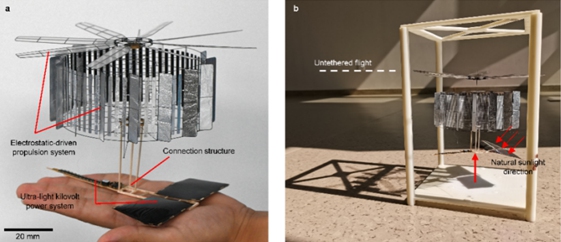Chinese researchers develop ultralight sunlight-powered micro aerial vehicle for sustained flight

CoulombFly. (Photo: WeChat account of Beihang University)
Chinese researchers have successfully developed an ultralight sunlight-powered micro aerial vehicle (MAV) weighing only 4.21 grams, capable of sustained flight using natural sunlight as its power source, which is expected to have wide applications in the national economy, according to Beihang University. The study was published in the journal Nature on July 17.
The MAV has a wingspan of 20 centimeters and weighs 4.21 grams. It's powered by a new type of electrostatic motor as its engine core, which enables takeoff and sustained flight solely on natural light energy.
The research achievement was independently developed by a research team at Beihang University, and is expected to significantly increase the flight duration of MAVs, expanding its range of applications in the future, the university said in a report published on its official WeChat account on Thursday.
Limited flight duration is a considerable obstacle to the widespread application of MAVs, especially for ultralight MAVs weighing less than 10 grams, which, in general, have a flight endurance of no more than 10 minutes, researchers from Beihang University wrote in the study published in Nature, titled "Sunlight-powered sustained flight of an ultralight micro aerial vehicle."
Previous studies have not been able to achieve sustained untethered flight of ultralight MAVs fully powered by natural sunlight due to limited payload capacity and low lift-to-power efficiency of traditional propulsion systems. Sunlight power is a potential alternative to improve endurance of MAVs, according to the study.
Due to MAVs' small size, light weight, and high maneuverability, MAVs can perform specialized tasks such as photography, detection, and transportation in confined spaces with wide applications in the national economy.
MAVs often have short flight times, because traditional electromagnetic motors used in these vehicles generate heat and have low energy conversion efficiency when miniaturized. The efficiency can drop to below 10 percent, making it difficult to meet flight requirements even with solar energy as a power source due to limitations in solar panel area, according to the researchers.
In order to solve the problems, researchers developed a micro electrostatic motor, and successfully tested flying the electrostatic aerial vehicle "CoulombFly." The motor has low speed, low heat generation, and high efficiency in a small size, making it a breakthrough in micro engine principles, said the university.
Photos
Related Stories
- Deploying drone for forest patrolling reduces disaster risks in NE China's Yichun
- China's drone industry reports rapid growth in H1
- DJI makes world's 1st successful drone delivery tests on Mt. Qomolangma
- Drones utilized to enhance quality, efficiency at grassroots power grids in northwest China
- Drones soar into wider application in China
- High-altitude transport test demonstrates potential of China's drone industry
Copyright © 2024 People's Daily Online. All Rights Reserved.









